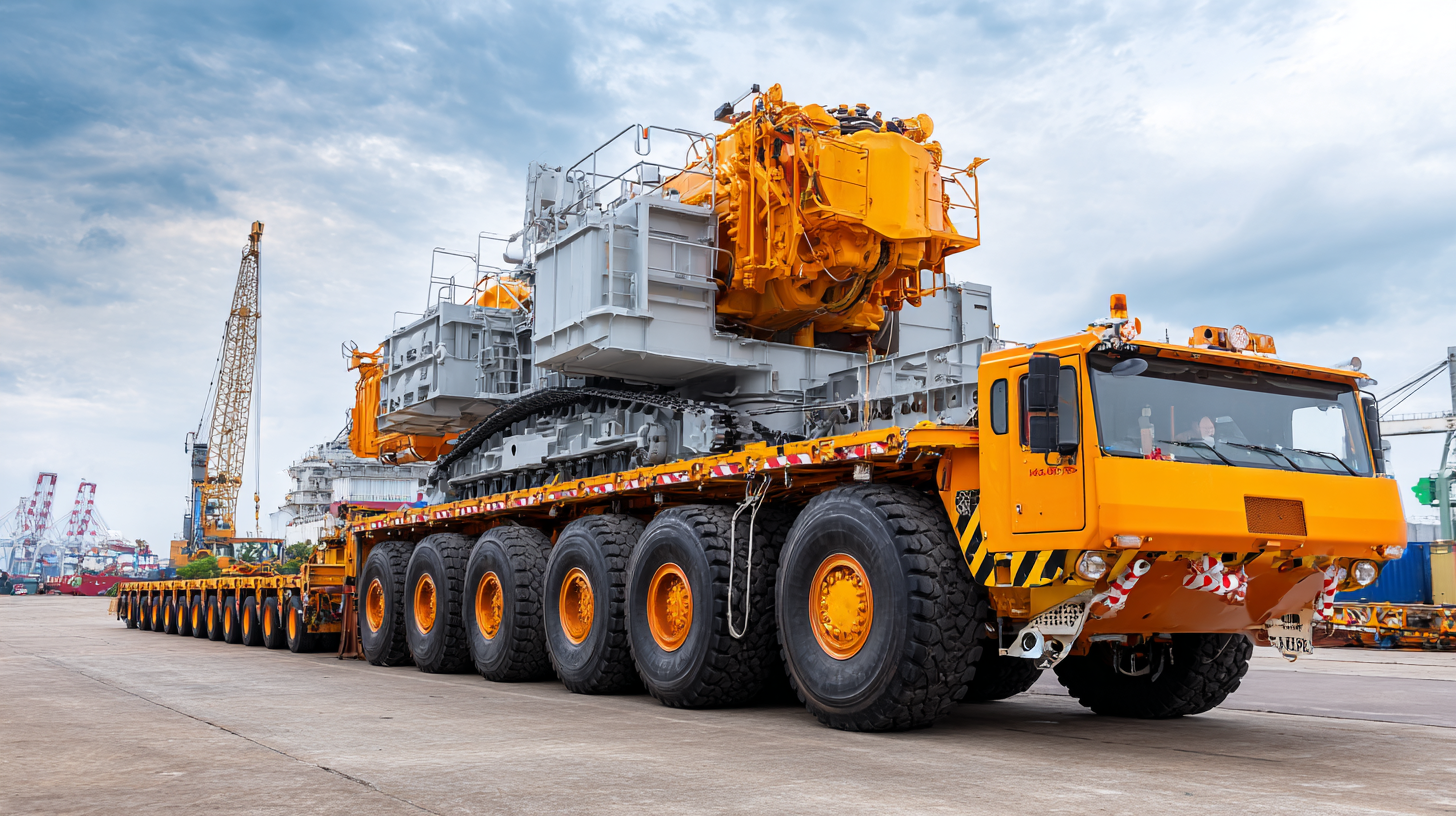How to Safely Move Large Equipment in 2025 for Maximum Efficiency and Minimal Risk
In the rapidly evolving landscape of logistics and machinery transport, the significance of safely moving large equipment cannot be overstated. As businesses increasingly rely on advanced technologies to enhance operational efficiency, the methods of transporting substantial machinery must also adapt accordingly. Renowned expert in large equipment logistics, Dr. Edward Mitchell, emphasizes, "The key to maximizing efficiency in moving large equipment lies in integrating innovative strategies with a strong commitment to safety."
The year 2025 presents both challenges and opportunities within this industry. As equipment becomes more advanced, the logistical considerations involved in moving such enormous assets must reflect these changes to mitigate risks and elevate productivity. With an ever-growing emphasis on safety regulations and technological integration, understanding the nuances of large equipment transport is critical for businesses seeking to optimize their operations.
This guide will provide essential tips curated from industry leaders on how to safely navigate the complexities of moving large equipment while ensuring maximum efficiency and minimal risk. Embracing these strategies will enable organizations not only to safeguard their investments but also to streamline their processes, ultimately leading to a more robust and resilient operational framework.

Strategies for Implementing Advanced Safety Protocols in Heavy Equipment Transportation
In 2025, moving large equipment safely will require a focus on implementing advanced safety protocols that adapt to the evolving technological landscape of the construction and logistics industries. As reported, improving job site safety necessitates innovative ideas and technology that prioritize a culture of safety. This means adopting rigorous safety standards and continuously educating teams on the latest protocols to mitigate risks associated with heavy equipment transportation.

Tips for Implementing Advanced Safety Protocols:
- Embrace Automation: Leverage automation technologies not only to enhance operational efficiency but also to reduce human error. Automated systems can monitor equipment conditions and provide alerts, ensuring that safety measures are promptly followed.
- Regular Training and Drills: Consistently conduct training sessions that incorporate the latest safety procedures and technologies. Ensuring that all team members are aware of the protocols fosters a safety-first mindset on site.
- Invest in Safety Technology: Utilize advanced safety tools such as real-time monitoring devices and data analytics to track equipment performance and potential hazards. This proactive approach can significantly decrease the likelihood of accidents during transportation.
By emphasizing these strategies, companies can maximize efficiency while minimizing risks during large equipment relocation.
Utilizing Robotics and Automation to Enhance Efficiency in Transporting Large Machinery
In 2025, the integration of robotics and automation in the transportation of large equipment will significantly enhance efficiency and minimize risks. Recent advancements, such as innovative logistics robots, are already transforming how tasks are accomplished in various industries. For instance, companies have begun using automated systems to move harvested crops from production sites to centralized storage areas, showcasing the potential for increased operational efficiency. This trend reflects a broader movement in logistics, where the automation potential remains among the highest across sectors.
Simultaneously, leading firms are experimenting with advanced robotic solutions to optimize sorting and fulfillment processes within warehouses. This shift not only amplifies productivity but also mitigates the impact of labor shortages by utilizing intelligent systems to handle repetitive tasks. Moreover, the development of customizable transport robots tailored to specific conditions demonstrates the industry's commitment to creating adaptive solutions for moving large machinery. As the transportation and warehousing sectors continue to embrace these technological advancements, the role of automation will be pivotal in driving progress and enhancing overall safety in operations.
Key Industry Statistics on Equipment Damage Rates During Moves and Effective Mitigation Techniques
Moving large equipment can be a daunting task, especially with statistics indicating that the damage rate during moves can range from 10% to 20%. This figure highlights the importance of developing effective mitigation techniques to ensure the safety of equipment and personnel. Implementing a comprehensive risk assessment before the move is essential. By evaluating potential hazards in advance, teams can identify strategic solutions to prevent incidents from occurring.

Tips: One effective technique is to use specialized rigging equipment tailored for heavy loads. Make sure to train all personnel on proper handling practices to reduce human error during the move. Additionally, employing technology such as GPS tracking and real-time monitoring can help in anticipating potential issues and maintaining optimal workflow.
Another key aspect is communication. Establishing a clear line of communication among team members can dramatically reduce misunderstandings and mistakes. Regular meetings before the moving date can ensure that everyone is on the same page regarding safety protocols and moving strategies. Prioritizing these factors not only enhances efficiency but also safeguards valuable assets during transport.
The Role of Environmental Factors in Equipment Relocation: Weather and Terrain Considerations
When planning to relocate large equipment in 2025, it is crucial to consider environmental factors such as weather and terrain, especially in light of increasing climate change impacts. The transportation infrastructure in the U.S., which is vital for moving goods efficiently, is experiencing significant strain due to extreme weather events. According to a report by the National Academy of Sciences, climate change will lead to a rise in severe storms, flooding, and longer drought periods, greatly affecting logistics and operational timelines. As such, thorough assessments of weather patterns—particularly in terms of predicted rainfall and temperature extremes—are essential for safe equipment relocation.
Terrain analysis further complicates the logistics of moving large equipment. A study by the Institute for Transportation Engineers suggests that planning for sites in severely restricted terrain can mitigate risks. Adverse conditions such as muddy ground or unstable surfaces can pose significant safety threats during transportation. Therefore, utilizing advanced terrain analysis tools that factor in the likelihood of weather-related disruptions can enhance decision-making, ensuring that relocation strategies minimize both risk and downtime. As the impacts of climate change continue to intensify, such proactive measures will be key to maintaining operational efficiency in equipment relocation.
How to Safely Move Large Equipment in 2025 for Maximum Efficiency and Minimal Risk - The Role of Environmental Factors in Equipment Relocation: Weather and Terrain Considerations
| Equipment Type | Weather Conditions | Terrain Type | Safety Precautions | Estimated Efficiency (%) |
|---|---|---|---|---|
| Crane | Clear, No Wind | Flat and Stable | Use of Outriggers | 95 |
| Forklift | Rainy, Wet Ground | Uneven Terrain | Inspect Tyres and Load Balance | 85 |
| Excavator | Overcast, Mild Temperature | Soft Ground | Check Stability | 90 |
| Backhoe Loader | Sunny, High Wind | Rocky Terrain | Wear Personal Protective Equipment | 80 |
| Dump Truck | Clear, Snow on Ground | Slippery Inclines | Ensure Traction Control | 75 |
Cost-Benefit Analysis of Investing in Specialized Equipment for Safe Large-Scale Moves in 2025
When considering a move of large equipment in 2025, a thorough cost-benefit analysis is essential. Investing in specialized equipment not only enhances safety but also improves efficiency during large-scale moves. While the initial costs may seem high, the long-term benefits often outweigh these expenses. From reducing the risk of damage to minimizing labor costs, the right equipment can lead to substantial savings.
Tips: To maximize efficiency and safety, assess the specific needs of your equipment. Consider using hydraulic lifts for heavy machinery and automated guided vehicles for transporting items across long distances. Additionally, investing in proper training for staff on new equipment will help mitigate potential risks associated with mishandling.
By prioritizing investments that align with your operational needs, you can ensure that you maintain a competitive edge. Evaluating the right equipment not only streamlines the moving process but also provides peace of mind knowing your assets are protected. Planning ahead with quantified benefits in mind will lead to smarter decisions in your large equipment moves.



